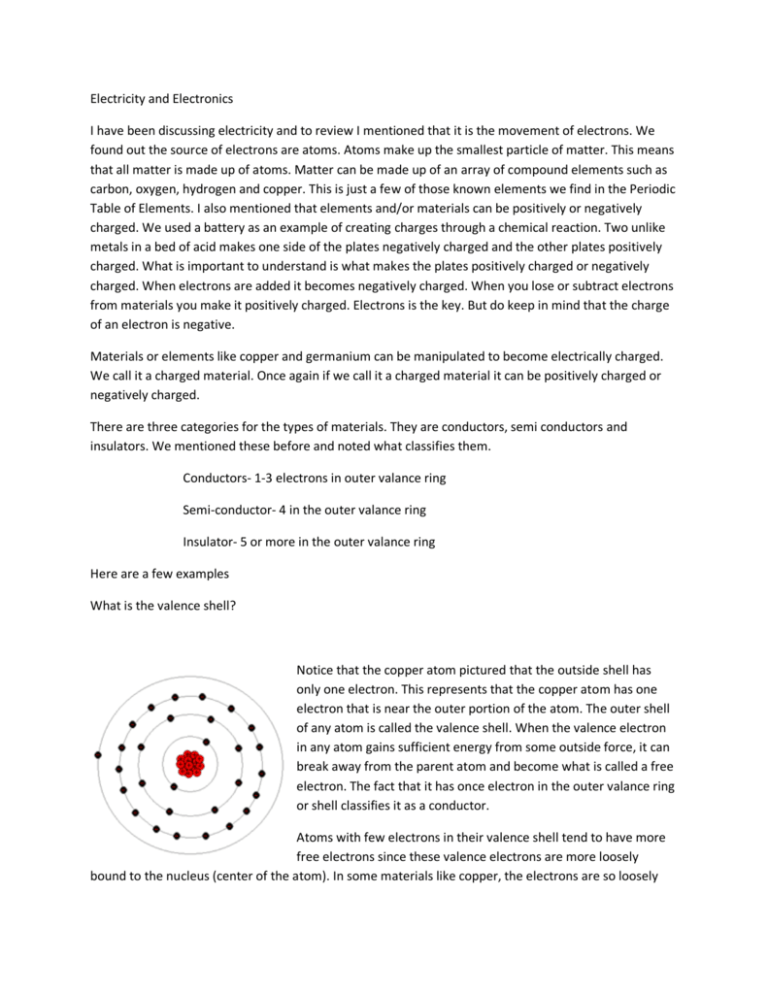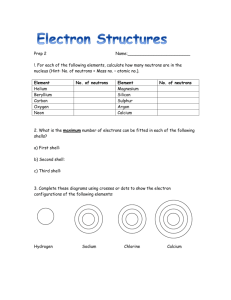Electrical Series
advertisement

Electricity and Electronics I have been discussing electricity and to review I mentioned that it is the movement of electrons. We found out the source of electrons are atoms. Atoms make up the smallest particle of matter. This means that all matter is made up of atoms. Matter can be made up of an array of compound elements such as carbon, oxygen, hydrogen and copper. This is just a few of those known elements we find in the Periodic Table of Elements. I also mentioned that elements and/or materials can be positively or negatively charged. We used a battery as an example of creating charges through a chemical reaction. Two unlike metals in a bed of acid makes one side of the plates negatively charged and the other plates positively charged. What is important to understand is what makes the plates positively charged or negatively charged. When electrons are added it becomes negatively charged. When you lose or subtract electrons from materials you make it positively charged. Electrons is the key. But do keep in mind that the charge of an electron is negative. Materials or elements like copper and germanium can be manipulated to become electrically charged. We call it a charged material. Once again if we call it a charged material it can be positively charged or negatively charged. There are three categories for the types of materials. They are conductors, semi conductors and insulators. We mentioned these before and noted what classifies them. Conductors- 1-3 electrons in outer valance ring Semi-conductor- 4 in the outer valance ring Insulator- 5 or more in the outer valance ring Here are a few examples What is the valence shell? Notice that the copper atom pictured that the outside shell has only one electron. This represents that the copper atom has one electron that is near the outer portion of the atom. The outer shell of any atom is called the valence shell. When the valence electron in any atom gains sufficient energy from some outside force, it can break away from the parent atom and become what is called a free electron. The fact that it has once electron in the outer valance ring or shell classifies it as a conductor. Atoms with few electrons in their valence shell tend to have more free electrons since these valence electrons are more loosely bound to the nucleus (center of the atom). In some materials like copper, the electrons are so loosely held by the atom and so close to the neighboring atoms that it is difficult to determine which electron belongs to which atom. Under these conditions, the valence or free electrons tend to drift randomly from one atom to its neighboring atoms. Under normal conditions the movement of the electrons is truly random, meaning they are moving in all directions by the same amount. However, if some outside force acts upon the material, this flow of electrons can be directed through materials and this flow is called electrical current. Materials that have free electrons and allow electrical current to flow easily are called conductors. Many materials do not have any free electrons. Because of this fact, they do not tend to share their electrons very easily and do not make good conductors of electrical currents. These materials are called insulators. There will be more information on this later. (Taken from the NDT Resource Center. http://www.ndt-ed.org/EducationResources/HighSchool/Electricity/valenceshell.htm) On the other hand you have semi conductors and insulators. If there are 4 in the outer valance shell or ring, it is classified as a semi-conductor. As you can see from the image, you can count that there are 4 electrons orbiting around the outer shell or ring of Silicon. This makes it a semi conductor. There are other semi conductors but silicon is well known. Insulators have 5 or more in their outer shell or ring. Note the differences between Boron, Silicon and Antimony. Boron has 3, Silicon 4 and Antimony has 5 in their outer valance shells. Solid State, according to Wikipedia the definition is :Solid-state electronics are those circuits or devices built entirely from solid materials and in which the electrons, or other charge carriers, are confined entirely within the solid material In order to understand it we need to manipulate charges and create them. Examples of solid state components are transistors and diodes. There are made up of doped materials. Doped means that a conductor or semi conductors are molded together to create a charged material. Lets look at Silicon once again. We found that it has 4 electrons in its outer shell. If we look at Boron we can see it has 3 in its outer shell. One is a semi conductor the other is a conductor. As I continue here on this chapter, remember what is the definition of electricity. It is the movement of electrons. Movement! If electrons are moving, you have electricity! With that in mind, let’s revisit the doping process. If I take Silicon, a semi-conductor and melt it but then add a bit of Boron which is a conductor, we now have a semi-conductor now mixed with a few Boron atoms which has three in its outer shell. As they solidify we now have a material that will be behaving differently. You have atoms now wanting to attract and push an electron. Note that Silicon has four electrons in its outer shell but Boron has only three. This now creates a hole making this material positively charged. There is an imbalance of electrons since the neighboring silicon atoms are requiring 4. This makes the material P Type. It is positively charged in that Boron has created a need for an electrons. (image from scan dig) If you now dope Silicon with Phosphorous, you create a negatively charged material. Phosphorous has five in its outer shell and now has an extra electron. This material has surplus of an electron and it will be attracting it yet releasing it. This makes this material an N Type. Through the process of doping you can make N and P type materials. A diode is an N type with a P type material. In order to make a Diode you first need an N type material and a P type material. Once that is made, you now fuse them together to make a P N JUNCTION. This is also known as a Diode. The quality of Diode is determined by the purity of the materials used and how much it is doped. Note that the P side on a diode is known as the ANODE and the N side is known as the Cathode side. A transistor is not that far away which we will discuss next week! Hint: PNP or NPN.






